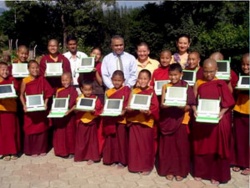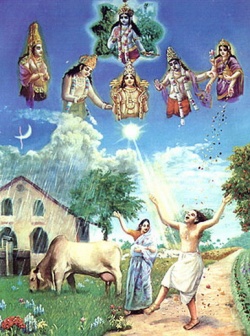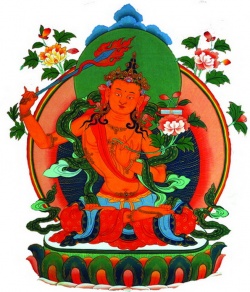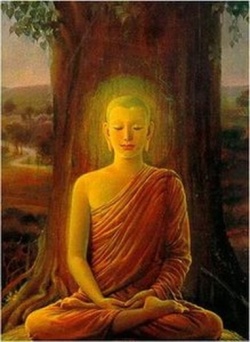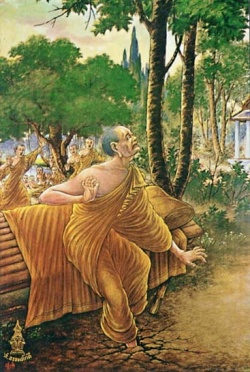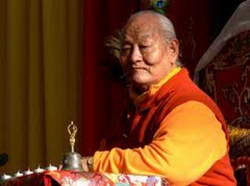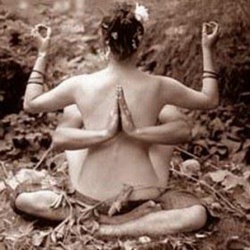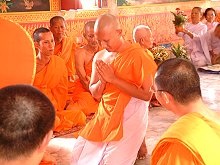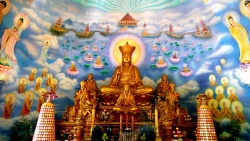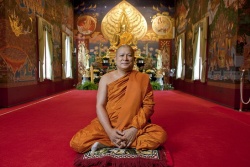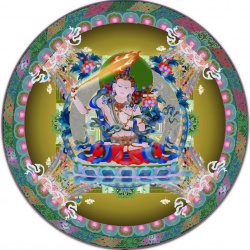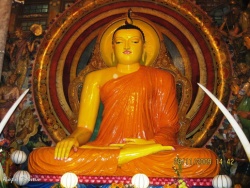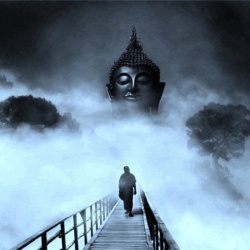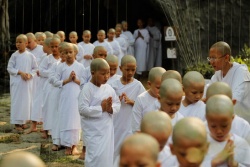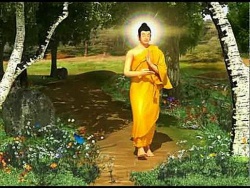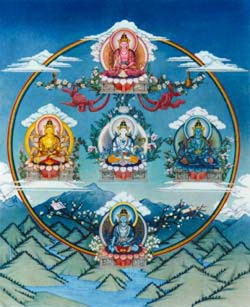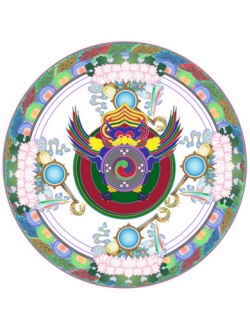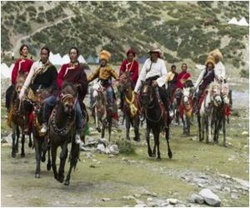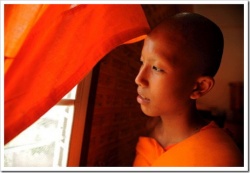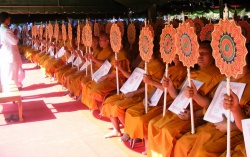Buddhist Studies and its Impact on Buddhism in Western Societies: An Historical Sketch and Prospects Max Deeg (University of Vienna)
Introduction
There is no doubt that Buddhism has come to the West and the respective story is a fascinating one. There has been a flood of publications on almost any aspect of Buddhism in the West, for almost any country belonging to that very undifferentiated cultural-geographic entity, in the past two decades or so. The studies have multiplied to an extent that long bibliographies on different aspects and regions of Buddhism in the West - Buddhism in Europe, Buddhism in America, Buddhism in Australia, Buddhism in the past, Buddhism in modern society - have been published. What we do not have yet, however, is a comparative study of the different "Buddhisms" in the West, that is: the different processes of reception and their interdependency on Buddhist studies and vice-versa.
The following article is divided roughly in two parts: in the first one I will describe the history of Buddhism as an object of studies and as a living religion in the West, demonstrated in the cases of Germany and the United States, and the interrelation of both aspects of Buddhism in a few strokes. In the last part I will try to sketch some differences between the developments in America and the German speaking countries European and the possible underlying reasons in context with social, political and intellectual backgrounds. I will end with some very short remarks on the future of both Buddhism in society and a possible role of Buddhist studies.
First Contacts
Before the beginning of the 19th century[1], the beginning of professional Sinology and Indology, Buddhism was known to the Western world only sources either not aware of the specifics of the religion or somewhat distorted by religious and colonial propaganda like in the reports of Catholic missionaries to the Far East, China and Japan, and to Tibet.
The very first contact of the West with India is going back beyond the times of the Macedonian-Greek king Alexander the Great but there is no direct source on Buddhism. Most information on India of that time we owe to the Greek embassador of the Greek ruler Seleukos Nikator from 302 B.C. until 288 B.C. in the capital of the Maurya-kingdom of Ashoka's grandfather Candragupta (Sandragottos), P?æaliputra (Palibothra, today's Patna), Megasthenes[2], who has, however, no direct references to Buddhism, but only mentions ±ramaÏas (sarmanes) being taken as hints to Buddhist and other mendicants. There has been and still is discussion on the possible influence of Buddhism on late Neoplatonism and early Christianity and especially the "hybrid" school of the Gnosis, laying emphasis on wisdom for attaining individual insight and redemption[3]. This goes so far that the epithet of the teacher of the famous philosopher Plotinus (ca. 205-270), Alexandrian Ammonius Sakkas (died ca. 242), should be a derivation of Ö?kya, showing the Buddhist affiliation of the philosopher[4]. Clemens of Alexandria (ca. 150-215) reports in his Stromateis (ca. 200 A.D.) about "Some, too, of the Indians obey the precepts of Boutta and; whom, on account of his extraordinary sanctity, they have raised to divine honours."[5] One early Christian writer, Saint Hieronymus (ca. 347-419 A.D.), even pointed out to the similarity between the birth of Jesus and the Buddha: "There is the tradition that Budda, their leader of their teaching, was born from the lap of a virigin"[6]. After that early period there is a sort of gap of information on Buddhism until the beginning of the Middle Ages.
In medieval times then, information on Buddhism was relatively restricted: we have, of course, the report "Description of the World" ("Divisament dou Monde", or: "Il Milione") of the famous Venetian Marco Polo (travelled 1275-1291), who, in typical Christian attitude, describes Tibetan and K?±mrian Buddhist monks (bacši = boshi ³Õ®v and sensi or sensin : xianshi ¥P®v or shengxian ¸t½å?), without calling them Buddhists, involved in magic and sorcery (ch.55). In his description of the island of Seilan (Ceylon) he also has a passage on the Buddha - he uses the Mongolian form of the name Sagamoni Burcan[7] -, and his life at the end of which he makes a remark typical for the christocentric worldview of this time and the following century (ch.179): "For truly if he had been a babtized Christian he would have been a great saint with our Lord Jesus Christ for the good life and pure which he led."[8]
Marco Polo's description of the life of the Buddha is relatively extensive and correct in details, but it is not the earliest account of the biography of the Lord. It is certainly and partly assembled by hearsay but also from the early medieval legend of "Barlaam and Josaphat", Josaphat being a corrupted form of Bodhisattva[9]. This legend, whose textual origin and history is still unknown, gained a particular popularity after it was translated from the Georgian language into Greek around 1000 A.D. and subsequently into Latin (1048 A.D.). It became part of the most popular compendium of hagiographies in the Middle Ages, Jacobus de Voragine's "Legenda Aurea" (13. century), but its Buddhist origin has not been recognised in its Christian disguise, although there is already a gloss in some versions of Marco Polo's report about the similarity between the Buddha-legend reported there and the legend, and despite the fact that the Portuguese Diego do Conto had already in 1612 pointed out that Josaphat and the Bodhisattva Ö?kyamuni may be the same person[10].
Information about Buddhism in the following period of the Christian missionaries, reaching its climax in the 17th century with the advent of the Jesuit mission in East-Asia and Central-Asia (Tibet) so closely and well-known connected with the names of Matteo Ricci and others in China and Franciscus Xaverius (1506-1552) in Japan, and Antonio d'Andrade (1580-1634), Ippolito Desideri (1684-1733) in Lhasa, was almost restricted on their reports[11]. What we find in philosophical and learned sources in Europe prior to the 19th century and shortly after it is mainly a combination of the pieces of information from the classical, medieval and missionary-sources.
Although Europeans knew some details about the Buddha and his teaching from these missionary reports and from ethnographical literature it was not before the first half of the 19th century that it became standard knowledge that the religions of Ceylon, Burma, Thailand, Tibet, Mongolia, China and Japan were indeed going back to the same founder, the Buddha[12]. The German philosopher Kant, for instance, refering mainly to Marco Polo and the younger travel reports in his readings on "Physical Geography" (composed before 1760!) was rather puzzled by the fact that there was a religion in South- and Southeast-Asia whose founder had totally different names: "In all these countries the Indian ["indianische"] religion is predominating with the difference that it was spread by a person called Budda in Ceylon, Schaka in India, Samanakodam in Siam, whose soul had wandered around on earth until it went up to Heaven. …"; for China, Japan and Tibet he did not identify Buddhism as such: "The sect of the Fo [in China) believes in the transmigration of souls. …", but the Lotuss?tra, which he calls "the book of Flowers" (following the reports of the German physician Engelbert Kämpfer) and "religious book of the Japanese", was not recognized by him as belonging to Buddhism[13]. Etymological association was the technique of the day, where Gotama could be explained as "good man" (German: "Guter Mann") and the Manichaeans were declared as a sect from Tibet, because of the well-known formula "Oò mani padme huò". Even a philosophers's knowledge who referred to Buddhism all the time as Arthur Schopenhauer was very much restricted through the sources which were published and he does call a lot of matters Buddhist which were indeed collected from Hindu-sources, especially from the Upaniãads[14].
The Beginnings of Buddhist Studies
As you all may know the advent of Buddhism as an object of academic research happened before Buddhism was established as a living and practiced religion in the West. It was closely connected to the discovery of India and its languages and literatures by Western scholars. It was mainly Sanskrit, the old language of the Indian Brahmins, which led to the discovery by British civil servants as William Jones, Ch. Wilkins and H.Th.Colebrooke[15] in India that far in the East there was a language, though related to the classical languages of Western cultures, Greek and Latin, in terms of regularity and formal richness was even superior to those. This was the beginning of Indo-European comparative linguistics which finally led to its abuse in order to support ideologically colonialist and nationalist tendencies and realities by the help of a mainly linguistically contructed ideology of racism which in the end incited an already latent anti-semitism in almost all countries in Europe around the end of the 19th century, but especially and best known through its Nazi form in the German-speaking countries.
The same discovery, however, also led to the study and investigation of classical Indian literature, the huge bulk of which, besides the poetic traditions of India, consisted of philosophical and religious works. There was first the big corpus of the Veda, the holy literature of Brahmanism which later developed into what we call now Hinduism. But from the second half of the 19th century it was also the literature of Indian Buddhism which came into the focus of the Western Orientalists.
After the linguistic gateway to the literature of India was tossed open by the establishment of the first chairs for the study of Sanskrit, Buddhist literature in Indic languages came into the focus of orientalists very soon. While the first Indologists - for instant the first German professor for Indology, called "Orientalistik" in these days, August Wilhelm Schlegel in Bonn (established 1818) and his brother Friedrich Schlegel in his famous "On language and wisdom of the Indians" ("Über die Sprache und Weisheit der Indier", 1808) - almost exclusively dealt with Brahmanic or Hindu material, early indologists like Wilson and Lassen[16] already included some references to Indian Buddhism in their main works; they could, however, not refer to original sources but used only Hindu-sources in Sanskrit. It was French Sinologists and Orientalists who studied Buddhism on the basis of original Buddhist texts of what they called then the Northern school of Buddhism, opposed to the Southern school which was Therav?da in Ceylon. The first scholar who worked with and on these texts was the French Abel Rémusat who translated the travel-record of Buddhist pilgrim to India, Faxian ªkÅã. In his annotations Rémusat gives a kind of surview of the state of knowledge on Buddhism in his time[17]. A real flow of Buddhology started of around the middle of the 19th century with the "discovery" of P?li as the "original" language of the Buddhists and a bundle of Buddhist Sanskrit texts from Nepal, sent back by the British representative in Kathmandu, Hodgson. It was Eugène Burnouf, who in 1826 had already published together with the Danish-German indologist Lassen a short treatise "Essai sur le Pali ou langue sacrée de la presqu'île au-delà du Gange" (Paris) and now shifted to the study of the texts of Mah?y?na. The outcome of his studies was Burnouf's translation of the Lotuss?tra, the Saddharmapuϯarkas?tra (completed 1839, printed 1841, published postumus 1852), and the first compendium on Buddhism in a European language, the "Histoire du Bouddhisme indien" (1844), in which the French scholar mainly relied on his Sanskrit sources from Nepal received by the British representative in Kathmandu, Brian Houghton Hodgson, in 1837[18].
This first wave of Buddhist studies in Europe - American scholars were rather inactive in this field of study, as Thomas Tweed has shown in a short article[19] - based on the Northern sources from East-Asia and the Him?laya-region, including more and more Tibetan material[20], was very soon overflowed by the interest in and research done on the P?li Tipiæaka. The reasons for this shift of interest are to be found in the historicism of the second half of the 19th century, trying to trace back and reconstruct the most authentic and original form of everything found in human history. The P?li-sources with their seemingly "orientalist" - in the sense of Edward Said - and "protestant" and unmythical character was the purest source for the word of the Buddha for scholars like the British Thomas Rhys-Davids[21], the German Hermann Oldenberg and many others who joined the work of the new-founded P?li Text Society, and this originally scholarly notion had, as we will see below, its heavy impact at least on German Buddhism of the early period.
So, the first period of interest in Buddhism in Europe was clearly a scholarly and intellectual adventure and this continued to be so for a long time until the first small communities of practicing Buddhists in Germany came into existence, which consisted characteristically mainly of academics and even Orientalists.
But the influence of these first acedemic achievements in the study of Buddhism was beyond the Western hemisphere: Buddhist modernism[22], which comprises an approach to traditional Buddhism in Asian countries, was instigated by this rise of Western Buddhist Studies and the sympathy and conflict with Buddhism in scholars's circles but also in circles searching alternative lifestyles. The concept of the groups, being rather minorities in their motherlands but representing their kind of Buddhism to the outside world - we now would probably say: internationally -, was and is to adapt Buddhism to modern societies and modern sciences. This was achieved on the social level by a trend of "protestantization" of Buddhism[23]: the instigation of more content-oriented study of the own Buddhist scriptures, in some cases by Western Orientalist methods, and a tendency of including the laypeople more into religious life to an extend that monastics played a rather unimportant role or no role at all. A reduction of the traditional saÏgha's role in Ceylon's Buddhist revival was instigated through the efforts of Colonel Olcott and represented by the non-monastic type of Buddhists like the paradigmatic (David Hervavitarne) Dharmap?la, leading to the foundation of the Mah?bodhi-Society in 1891 in order to revive Buddhism in Ceylon and in its homeland India[24] where it had disappeared by the 12th, 13th century; it was in this Society that the saôgha took pace again with the social and religious developments[25]. Similar trends as in Ceylon, though more cooperational with the traditional saôgha than the movement was there in the beginning, can be observed in Burma (Myanmar) and Thailand, although the differences have to be seen: Burma's and Thailand's Buddhist Modernisms lacked the influence from Western parties such as the Theosophical Society[26] and were only indirectly instigated through the colonial presence of the British Empire, respectively the pressure of the Western powers to open up the country.
Burma and Thailand were then different in respect of modernist developments: while the Burmese movement led to the "revolutionary" tendencies towards the independence of the country from British rule[27] and socialist ideology, the first wave of what can be called Buddhist modernism in Thailand, already instigated by Mongkut, the later R?ma IV, in the first half of the 19th century, was intended to stabilize the royal rulership and to consolidate the country's and the nation's unity against the Western pressure and influence, falling back however, on Western scientific models of interpretation and analysis. The resulting study of the Buddhist canon and strict interpretation of the Vinaya lead to the formation of the Thammayutika-Nik?ya fraction of the Thai saôgha under king Chulalongkorn[28]. In China it is definitely Taixu ¤Óµê[29] and the Lay Buddhist Movements[30] in the first half of the 20th century who represent Buddhist Modernism[31]. Meiji-Japan and the following decades[32] saw a growing number of lay-Buddhist movements like the Reiy?-kai ÆF¤Í·|[33] and their offsprings Rissh?-k?sei-kai ¥ß¥¿Ë³¥¿·| and the S?ka-gakkai ³Ð¤Æ¾Ç·|[34] attracting laypeople and sometimes opposing the nationalist policy of the government. On the other hand there was, from the beginning of the Meiji-era[35], a strong movement to establish Buddhist studies as a full-fledged academic field which was mainly streamlined along the Western model by the first Japanese scholars like Buny? Nanj? who studied under such eminent researchers as F.Max Müller, while the number of students of Buddhism in the West from other Buddhist countries, China, Thailand, etc, before the end of World War II is very low. Korea until the end of Japanese rulership was pressed to follow the models of Japanese Buddhism and experienced a Buddhist revival after 1945 in the Southern part of the divided country both in terms of emmacipation of lay-Buddhists and of a focus on Buddhist studies[36].
Buddhism in the West - Europe, especially Germany
The early history and situation for Buddhism as a religion was different in the different European countries and cultures. I will restrict myself to German-speaking countries. The reason for this is not only a question of restricted space but also the fact that the reception process of Buddhism in the different European countries with their different identities and national histories cannot be described as a monolithic one, but developed along contextual lines of the historical reality of these countries, receiving different Buddhist "input" from different sources, e.g. England from its colonies Ceylon and (later) Birma, France from its South-Asian colonies[37]. The restriction can also be justified by the fact that Germany and Austria seem to have - together with Portugal - the highest rate of sympathy with Eastern religions and so-called native religions not belonging to the European mainstream (Protestantism, Catholicism)[38].
The special historical and political setting of the German-speaking countries before World War I, the "Deutsche Kaiserreich" (German Empire) and the "Königliche und Kaiserliche Monarchie" (Empire (of Austria) and Kingdom (of Hungaria)) which included Hungaria was marked by the fact that both empires were not involved in direct colonial activities in Buddhist countries. This very situation contributed to the fact, that - compared with England with its South-Asian colonies and France with its South-East-Asian colonies - Buddhism as a religion could start from a less prejudiced but also more "naïve" foundation without a permanent contact and friction with Asian countries. The outcome was, despite the intellectual and rational habitus and aim of the first movements, a rather romantic vision of Buddhism as an individually oriented lifestyle. The orientation of early German Buddhism on the Therav?da, or to be more correct: P?li-Buddhism was so strong, that even the few Germans who had contact with another form of Buddhism than Therav?da did so, however, through their interest in Therav?da and as an introduction to German Buddhism I will give you an example of one of these people.
To show how Buddhism practiced in the German-speaking world has been more a question of (almost totally) private "lifestyle" than of socially practiced faith shown to and realized by the outside world and at the same time that Chinese Buddhism had almost no impact on the German-speaking world, I would like to give you an example from my own biography.
I was born in a very small town - in Asia it would be called a village by size: 6000 inhabitants - in Southern Germany. It was not before I already had studied Buddhism at the university - how else in Germany of the seventies than by learning and by reading P?li after having done Sanskrit before - and then later history of religions in general that I became aware that, despite the fact that a handful of famous Therav?da-monks originally were Germans, there had been only a handfull of Germans who had become a Buddhist monks or nuns in the Chinese tradition and the most active was Martin Steinke (1882 - 1966), his faming ªk¦W Daojun ¹D®m. He originally was a banker in Berlin and came from the typical German Therav?da-Buddhist circles in Berlin before he moved towards Mah?y?na, and finally decided to go to China to be ordained as a Mah?y?na-monk. He went to Nanjing together with Ignácz Trebitsch (1879 - 1943, died in Shanghai), a Jewish Ungarian-German adventurer and spy turned monk Zhaokong ·ÓªÅ (ordained 1931) and a very obscure and brutally dominant personality, who was probably the first Westerner to become ordained in the Chinese tradition[39]. Steinke received the precepts on the Qixia-shan ´ÏÁø¤s in November 1933. The group had been accompanied by three German ladies, two of whom committed suicide - one jumping into the Street of Malacca and another committing suicide - and one was ordained Daole ¹D¼Ö. After having arrived back in Germany in May 1934 Steinke and after activities such as speeches on Buddhism and Buddhist retreats he founded the "Buddhist Community" (Buddhistische Gemeinde e.V.) in 1937. In 1941 he was arrested for a short time by the Gestapo and his activities were interdicted until the end of World-War II. In 1956 he was invited to the sixth Buddhist Council in Rangoon[40].
Some years after I had read about this remarkable personality I was even more surprised to learn that he had lived his last decades in a neighbouring town, Bad Mergentheim, about 12 km from my own hometown, and that he had a small Buddhist circle there. He had been a personality in public life, mayor of a small town in the area and director of the bath-organization in Bad Mergentheim. I asked my father, who comes from the very community and went to school there, about Steinke / Daojun and his activities, and he told me that he knew about something going on in one old house in the town, but could not tell me any details.
But let us to go back after this short excurse to the beginning of Buddhism in Germany: at almost the same time as the intensified studies of P?li a movement was born through the notorious genius of a German-Russian womar which instigated non-academics' interest in Asian religions and, at least in the beginning of the movement, in Buddhism: the Theosophical Society of Madame Helena Blavatsky and her colleague, the American Colonel Olcott[41]. The German branch, the "Theosophische Societät Germania" ("Theosophical Society of 'Germania'"), was founded in July 1884, while the first Buddhist association in Germany, the "Association for Buddhist Mission in Germany" ("Buddhistischer Missionsverein in Deutschland") was not founded before 1903 in Leipzig.
It was in the last decaded of the 19th century that the first individuals, groups and communities of Buddhists in Europe appeared on the scene. Following the history of European scholarship in Buddhism and its outcome from the Theosophical Society, Buddhism in German-speaking countries such as the German Empire and the Austrian Monarchy[42] but not only there, until some period of time after World-War II focused mainly on the Therav?da-Buddhism of the P?li-canon which was taken as the original and authentic teaching of Gautama Siddh?rtha, who was Ö?kyamuni Buddha. Being a Buddhist meant to understand rationally - and sometimes also by intuitition - what was written in the Suttas of the Tipiæaka. So we find amongst the early German Buddhists some fine P?li-scholars who made the first translations of the Sutta-Piæaka into German, like Karl Seidenstücker, Paul Dahlke, Karl-Eugen Neumann (1865-1915) and Georg Grimm.
This does not mean, however, that the first German Buddhists were sectarianists; the range of topics reflected in the first German Buddhist journals and periodicals was truly cosmopolitan[43], even if this was more a program than an achieved reality. It was rather a lack of opportunity to have contact with other forms of Buddhism - except some encounters with representatives of Japanese forms of Buddhism - which kept German Buddhism in the track of almost exclusively Therav?da. German Buddhist groups of the first period, mainly located in the cities of Berlin and Leipzig, were not only closely interconnected to each other, they also had close ties with other non-mainstream groups such as "International Theosophical Brotherhood", "German Association of Monists", several association for the promotion of cremation, etc.[44]. They were usually consisting of only some members from the middle up to the higher range of society, a fact which did not prevent them to have struggles with each other, on the surface caused by the interpretation of the dharma, under the surface often stemming from personal inanimities and financial quarels[45]. The example of the differences between Georg Grimm and Paul Dahlke and the final split of the early Buddhist community into two main branches the so called "Old-Buddhist Community" (Altbuddhistische Gemeinde) and the "New-Buddhist Community" (Neubuddhistische Gemeinde) is a striking case for these strange
Paradoxically the early Buddhists in Germany, though they relied mainly on Therav?da-sources, did not become monks - those who did so, like the famous Ny?natiloka, left the country - but stayed laypeople. There was only a short period of time around 1907 that there were plans to establish a full-fledged Buddhist monastery in Germany: Ny?natiloka, living then as a bhikkhu in Birma, thought about living in a German vih?ra, which should get a steady flow of European bhikkhus trained in Birma by England-born bhikkhu Metteya. This idea, however, was turned down by Seidenstücker, the leader of the Mahabodhi-Centrale in Leipzig, who pointed out the impossibility of adapting Buddhist monastic lifestyle to the German social environment and a also the danger that "queer persons" could enter such a place and do damage to Buddhism in Germany. The whole project finally failed in 1912 because there was not enough donated money to realize it[46].
After World War I the centers of German Buddhism spread from Leipzig and Breslau to Hamburg, Berlin (Paul Dahlke) and with in Munich (Georg Grimm) Southern Germany was established as a center of P?li lay Buddhism which is intact until these days.
The orientation of early German Buddhism towards Therav?da, or to be more correct: P?li-Buddhism was so strong, that even the few Germans who had contact with another form of Buddhism than Therav?da did so, however, through their interest in Therav?da, and a second charactaristic was that there was direct interaction between scholars of Buddhism and the newly founded communities. German Buddhism in these decades may be described as a circle of mainly P?li-text readers without robes, almsbowls and viharas.
The situation changed after the suppression of most Buddhist activities suspected as un-German and pacifistic under the Nazis and after World War II: the new vogue - prepared by influentious books like Eugen Herrigel's "Zen und die Kunst des Bogenschießens" ("Zen and the Art of Archery"), Daisetsu Teitar? Suzuki's "Zen and Japanese Culture", the presentation of Asian traditions and religions by psychologist C.G. Jung but certainly fully launched by American influence - was Zen and meditation-oriented Buddhist practices in general and Therav?da-Buddhism lost ground until it began to have a revival after a new focus on its own spiritual tradition of vipassan?-meditation in the last years. Tibetan Buddhism arrived in Germany in the seventies, and Germany was by then back in the mainstream of development of Buddhism in the West. This wave of reception was certainly embedded in a general crisis of the generation in the sixties and the resulting "Sinnsuche", which led to a new wave of oriental exoticism, this time towards more individual and practical oriented - one should take notice of the epoch-transgressing idea of the conception of the "ex oriente lux" - religiosity and spiritualism[47].
Buddhism in the West - America
America's discovery of Buddhism in the 19th century was mainly an affair of intellectuals: "Most Americans remained apathetic or ignorant"[48] about Asian religions in general and those who did had to rely on European ethnographic and orientalist literature. There was misunderstanding what Buddhism really was: the famous American author Ralph Waldo Emerson, who had a deep interest in Asian religions, still in 1845 called the Bhagavad-gt? a "much renowned book of Buddhism"[49], and in 1906 Paul Carus was still struggling with the fact that interested Americans still confused Hinduism and Buddhism[50].
Besides very few academics it was mainly American protestant missionaries who were interested in the Buddhism as one of the religions they had to deal with in the regions they were trying to convert. Due to their proselytizing strategy Buddhism had to be and was brandished as being perfectly opposed to what Tweed has identified as markstones of American Victorian culture: "theism, individualism, activism, and optimism"[51], which meant: Buddhism was atheistic, against individualism, passive and pessimistic. This period lasted approximately until the publication of Edwin Arnold's poetic and sympathetic version of the Buddha's life, The Light of Asia, in 1879 which was pathetically received by a big number of educated Americans.
The next influx of Buddhism, which then marked the beginning what has been labelled as "American Buddhism" with European or white Americans as ist main supporters, came with and after the World's Parliament of Religions, held at the World Exhibition in Chicago in 1893. The interest in and the attraction to Buddhism or what was thought to be Buddhism had steadily risen during the seventies and eighties and the showdown between representants of the main Asian religions, especially of Hinduism and Buddhism, and their Christian invitors, who had invited them mainly to finally show their own superiority and the inferiority of the guest, fell on fertile ground: the sympathy for the Asian party had increased immensely until the end of the exhibition after which the first America on American ground, that a Swiss-American business-man from New York, Charles Strauss, took the three refuges, tri±araÏa, from Anag?rika Dharmap?la[52]. The strongest impact of participants of the World Parliament was definitely achieved by this very Dharmap?la and his Japanese S?t?-Zen counterpoart Shaku S?en[53]; both returned to the States to lecture on Buddhism and were in close contact with Paul Carus (see below).
As had already been mentioned, American contribution to the academic study of Buddhism was if not undeveloped so at least underdeveloped[54]. The major contribution was Henry Clark Warren's Buddhism in Translation (1896) while an earlier work of an American Buddhologist and Tibetologist, W. Woodville Rockhill's The Life of the Buddha and the Early History of his Order (Derived from Tibetan Works in the Bkah-Hgyur and Bstan-Hgyur), had already published in 1884, however with the well-known British Oriental publisher Kegan Paul, Trench, Trübner & Co.Ltd. in London.
It was the German-born Paul Carus (1852 - 1919), the editor of the journals The Open Court and Monist, who was one of the most fervent propagators of Buddhism in America around the end of the saeculum[55]. Carus, whose major aim was the reconciliation of religion and rationalism and sciences[56], was a kind of mediator between the Asian Buddhist leaders like Anag?rika Dharmap?la and Shaku S?en lecturing on Buddhism in America after the World Parliament of Religions, the European literature, orientalist and literary, and the American interested audience and readers.
The first Asian Buddhists in America have been the Chinese worker-immigrants coming to the United States in the wake of the Californian goldrush and settling subsequently as traders and workers at the West Coast. The first Chinese temple in 1853 in the States is attributed to the activity of the Chinese Sze Yap Company in Chinatown of San Francisco; it was not merely a Buddhist structure but a rather amalgam institution devoted to the goddess of Heaven (Tin Hou Temple : Tianhou ¤ÑÔ)[57]. However, the willingness of Americans even interested in Asian religions to see any connection between what was received in these times as Buddhism and the religious practices of these first Asian immigrants on American soil, was low, and so was the possibility to identify the religious activities of these mostly illiterate and non-educated Chinese workers who were without any support from religious specialists such as Buddhist monks: thus the elements of Chinese religion practiced in America was seen as "heathendom". This situation changed when the first wave of Japanese immigrants arrived from around 1885 on. It was especially the reformed Pure-Land denomination J?do-shin-sh?, most Japanese on the Archipelago were affiliated to (and officially still are), which started mission in the United States in order to provide the used Buddhist service to the Japanese diaspora[58] but also with the idea of gaining followers beneath the majority of white "Caucasian" population[59].
Tweed in his book on "The American Encounter with Buddhism" has distinguished three types of Buddhists for the early period (1844-1912)[60]: 1. the esoteric (or occult) type who usually had connections with the Theosophical Society around Madame Blavatsky and Colonel Olcott; this type was rather eclectic, looking for "spiritual" resources behind the traditions he referred to. 2. The rationalist type who corresponded most to the German Buddhists of the first generation. This type is represented best by Paul Carus, but it should be kept in mind that there were indirect connections to the first type through the fact that the main propagator of this type of Buddhism, Anag?rika Dharmap?la, was coming from the Theosophical tradition and the "monist" idea that matter and spirit were unified by the fact that they were "regulated by the same natural laws"[61]. 3. The romantic type, who subscribed to a kind of integral, individual and empirical move towards Buddhism mainly in its existing forms in Japan. This type was represented by aethetically oriented people and artists like Ernest Fenollosa, William Sturgis Bigelow, who both received the Bodhisattva-vows in the Tendai-tradition at Hiei-zan near Kyoto[62], and the widely read Lafcadio Hearn of British-Greek origin.
The first period of Buddhism in America was determined by the reception of Buddhist literature, primary and secondary, via Europe and its Orientalists, but also by intellectuals being attracted directly to Buddhist philosophy and practice without a direct study of the sources[63]. It may be described as an intellectual cocktail based on some "Buddhist" books[64] - which may be called "second hand" because they were written or compiled by Westerners - and Protestant Buddhism brought in by European Buddhologist literature and the lectures of Dharmap?la, mixed with some exotic, but real Japanese "Pure-Land"-Buddhism cherries and a bit of Zen-spices contributed by people like Shaku S?en and Daisetsu Suzuki[65].
The situation after World War II of the occupation of Japan, the Korean War and the Vietnam War and the protest reaction led to a boom and a popularisation of mainly "Zenist" Buddhist ideas and practices through the so-called "beat"-generation, represented for instance by authors like Jack Kerouac ("Dharma Bums"), Gary Snyder and others, which was one conditio sine qua non for the academic preoccupation with Buddhism which itself then was still intensified and extended with the influx of Tibetan Buddhism in America in the aftermath of the exodus of Tibetan Buddhist masters during the occupation of Tibet to the Indian exile through the Red Army.
Aspects of Buddhism in the West as an Object of Study and as a Practiced Religion - Differences and Similarities in German-speaking countries and America
As I have tried to show in the last two chapters, Buddhism in Germany had developed in close connection with the study of its primary sources, mainly of the Pali-canon, and that it was this kind of intellectual-academic Pali-Buddhism which dominated the Buddhist scene in the that country until the end of World War II. In America the impact of Buddhist studies on the development on Buddhism as a practice religion was rather low and Buddhism was mainly represented by the circles of Asian immigrants, the Japanese standing on the first front but the activities restricted by the Japanese Immigration Exclusion Act in 1924 and again by the internation of Japanese-Americans after the United States entered World War II against Japan. After World War II, however, the situation in both region seemed to become inverted somehow, as in the late fifties and the sixties there was a first trend of American Zen-practicioners to study their Buddhist textual and cultural tradition, while Buddhists in Germany concentrated more and more on meditation only, neglecting the study of Buddhism as an object of research. Interestingly enough this did not change significantly with the advent of new forms of Buddhism to the West, especially Tibetan traditions.
This last wave of Buddhist advent in the West is, as is well known, closely connected with the case of Tibet. After the Dalai Lama had fled to India in 1959 and more and more Tibetans had followed him into exile some of these Tibetans went to America and to European countries: Switzerland, for instance, has a rather fair community of exile-Tibetans and there is even a full-fledged Tibetan monastery in Rikon, a small village near Zürich. The time-table of the "dharma arriving in the West when the iron birds will fly in the sky", as the Indo-Tibetan patriarch Padmasaòbhava prophecied the spread of (Tibetan) Buddhism into the West, was almost the same in Europe as it was in America[66], though there was already an active group of Tibetan affiliation in Germany from 1952 on, the Arya Maitreya Maϯala of the German-born Lama Govinda alias Ernst Lothar Hoffmann (1898-1985)[67]. There is, however, also a difference in both encounters which again fits to the general lines of development: while only a few German became full-fledged Buddhist monks or nuns in one of the various Tibetan traditions[68], there were not a few Americans who took the robe and even entered the classical scholarly education like the most known of these, Robert Thurman. I think that it will be an interesting experience for the future to see how Tibetan Buddhist traditions will be presented and represented in the West after the first period of enthusiastic and also romantic reception seems to come to an end[69].
Another difference between Germany and America seems to be that there are not only fewer Western monks and nuns in the German-speaking countries, but that there the is also one difference in social behaviour of those whom Charles Prebish has called "scholar-practicioners"[70]: While in America scholars who are at the same time Buddhists, laymen or ordained, are usually quite outspeaking about this fact, we have, especially in Germany, the problem that even scholars who are members of Buddhist groups and the official organization of German Buddhists, the DBU (Deutsche Buddhistische Union, "German Buddhist Union"), will usually not so easily come forth with a statement. This seems to indicate that at least in the German-Speaking world Buddhist scholars being at the same time practicing Buddhists are not necessarily ashamed to show that they are actually Buddhists but still clinge to the somehow "traditional" idea that being a scholar means to be objective and that objectivity is not compatible with the confession to any form of religion or faith. The consequence of this is also that the field of public relation of Buddhism in Germany, especially performed by the DBU, is only represented by a few people with academic background in Buddhist studies, although there seems to be a tendency on the homepage of the DBU to create links to the relevant academic websites.
I have just mentioned the DBU several times. This institution marks, as far as I know, another difference not only between Germany but also other European countries and America[71]. While in America there is no and also obviously no need for a unified national association[72], the legal situation for religious groups in a Germany is a specific one. To put it into an actual context one may point out the debate of German politicians in the wake of the 11th September to abolish the privileagues for religious associations (Vereinigungen, Vereine) which is of course mainly aiming at and against Islamic fundamentalists. Because of a couple of reasons a social group - and religious groups are only recognized as a group in this sense - will try to get the status of "public utility" ("Gemeinnützigkeit") and than the status of an "association" ("Verein"[73]). The DBU was founded in 1955 as the "German Buddhist Society" ("Deutsche Buddhistische Gesellschaft") and changed its name into "German Buddhist Union" in 1958. The next step was the attempt to be recognized as a "Corporation of Public Law" ("Körperschaft des öffentlichen Rechts") in 1985 which would have legally brought the DBU on the same level as the other officially achknowledged religions, including the two main Christian Churches[74].
The advantages would have been a higher degree of public representation, a formal delimination against so-called New Religious Movements, but also financal support by the state[75] and the accession to the state-controlled media like radio and TV. The application was, however, turned down because the constitutional prerequisitions - a formally fixed common religious confession, no adequate organizational structure, a guaranty of continuity[76] - were not fulfilled. 1985 the DBU, on its annual members' assemblance, prepared and founded the "Buddhist Religious Community in Germany" ("Buddhistische Religionsgemeinschaft in Deutschland" : abbrev. BRG). The common confession is based on the Three Refuges, the Four Noble Truths and the Tenfold Noble Path; the "German Buddhist Union e.V., Buddhist Religious Community" ("Deutsche Buddhistische Union e.V., Buddhistische Religionsgemeinschaft"), as it was called from 1989 on, also publishes a magazine called "Lotus Leaves - Magazine for Buddhism" ("Lotusblätter - Magazin für Buddhismus"). The problems involved in the described process shows the difficulty of bringing together the different traditions of Buddhism in one common ecomenical association but also shows its necessity. In Germany's smaller neighbour, Austria, this process was succesfull in sofar as the "Buddhist Religious Community in Austria" ("Buddhistische Religionsgemeinschaft in Österreich") was already recognized as a Religious Community in 1982, is also publishing its own magazine and has even achieved to establish the teaching Buddhist religion in special school-classes[77].
Charles Prebish has described the situation of Buddhism in the West as one of two classes or of two Buddhisms: there is the Buddhism of the Western adepts and, more or less present, the Buddhism of the Asian communities there. Though this picture was mainly developed on the situation in North-America, it also stands true for most of the European countries with a more or less high degree of Asian citizens or immigrants. This means, that in general the Western Buddhists and the Asian Buddhists do not have to do with each other, even if they may well use the same cult-center, the same tempel, being even ordained in the same ordination-lineage. As has been stated, the Westerners tend to lay more importance on the personal practice of meditation, while the Asian Buddhists are more devoted to the traditional Buddhist activities like sponsoring the monks, being parts of the rituals and celebrating the traditional festivals.
For instance, depending on the existence of a colonial history, there are almost no or only few Asian immigrants who are Buddhists. Buddhist communities, as pointed out before, developed from the beginning of the 20th century on totally independently from Asian traditions, and the few cases in which, for instance, Asian, mainly Therav?da-monks, were brought to Germany, the experiment failed very soon, the monks returning to their home-countries. It was not before the sixties that a number of Buddhist Asians, mostly Campuchean and Vietnamese refugees, dropped into West-European countries in small numbers. These South-East-Asians eventually founded small Buddhist centers, very often without any support from a monk or priest but to cultivate their national identity in the small exile-groups abroad. In this case then the relation between the Asian Buddhist and the "white Buddhists" was the same as in America: a situation of mutual abstinence[78]. Groups of Tibetan affiliation fit into this scheme as they usually have no Tibetan member or - in the centers in the city - only one leading Tibetan teacher.
This seems to reflect a continuity in the reception of Buddhism either in America - and one could add to some extent: Australia - or in Europe which goes back to different "transmission-lines": while, as indicated, it was Buddhist studies, mainly of Therav?da-Buddhism with the only exception of France, which led to the first Buddhist communities consisting of non-Asian praciticioners with no guidance from a traditionally trained Asian master, the beginning of interest in Buddhism in America was lying in a different situation: it was the World Parliament of Religions in Chicago in which prompted the advent and stay of some Buddhist Asians in the U.S. as well as the first broader interest of educated Americans. The most impressive figure of An?g?rika Dharmap?la, Occultism, Mah?bodhi-Society and the Theosophists mark the forth and back between South-East Asian Buddhism and America. The second Buddhist personality who stayed in America for a longer period and had a larger impact on American Buddhism later was Daisetsu Teitar? Suzuki, propagating Japanese Zen.
The activities of most German Buddhists is very often more restricted to their own group than on ecumenical goals, despite the activities of some leading personalities, which is also reflected by the problems in the formation of the DBU, its common Buddhist confession and the fact that some groups did not join the DBU, while American Buddhists consider themselve rather naturally as belonging to a certain tradition because they usually do not have the conflict and the obligation of ecumenity which is caused by trans-fractional official status[79].
There is another difference between e.g. American Buddhism and Buddhism in Europe, closely connected to the first fact: so-called "Engaged Buddhism", an outcome of Buddhist ecumene and Buddhist reform movements and reflecting socially the core of the Buddhist ethics of compassion and charity, is not as developed in Europe as it is in America. One of the reasons for this - admittetly formulated a bit extremely - that most of the Buddhists in German-speaking countries are still on a kind of "self-experience-trip", usually in the framework of their own tradition-line. The last point may be illustrated by the harsh reaction of the Tibetan Kagyud-fraction of the Danish Lama Ole Nydahl on the dispute over the correct incarnation of the passed Karma-pa[80]. When people of this group are asked about their understanding themselves as Buddhists they usually first refer to a vague conception of universal Buddhism and then immediatelty jump on the group-level, emphasizing that their correct understanding of Buddhism is the one represented by the representative of the late Karma-pa, Lama Ole, how he is called by his first name[81].
Another reason for the more individual character of the already mentioned hesitation of scholars to come out as Buddhists and the tendency of German Buddhists to act very universal on the outside and very sectarian on the inside, comes from the general religious situation in Germany: the two big Christian "official Churches" ("Amtskirchen"), the Catholic and the Protestant Church, have a kind of monopoly not only in terms of traditional social standing of being the overall accepted religious affiliation-lines but also on the juridical side, because they both have so-called "concordance-treaties" ("Konkordatsverträge") between the German state and the representatives of these Churches. One of the effects of these regulations is that these Churches are subsided by a "church-tax" ("Kirchensteuer") which is automatically collected by the state from the salary of every German working individual unless he does not explicitely proclaim his not-belonging to one of these Churches. Another effect of this system goes right into the heart of the academic aspect: religion as a topic is officially taught at the Theological Faculties in German universities, which are normally state-universities[82] and are funded by the state but in terms of personal policy controlled by the Churches; this is more important for our issue than it sounds because quite some of the chairs for Religious Studies in Germany are situated in Theological faculties and everybody teaching there has to be a member of the respective Church (Protestant or Catholic). The high degree of social acceptance of the official Churches almost naturally leads to a suspicion against everything which German society uses to label by the pejorative word "sect" ("Sekte")[83], starting from other Christian groups and communities outside both mainstream-Churches and extending to Asian religious groups[84].
What is missing in Germany is the bringing-together of the academic study of mostly philosophical mainstream Buddhism with the study of positive religion which is or should be normally done in Religious Studies programs. Considering the importance of Buddhism in the public discourse there is a need for integral Buddhist Studies courses which, up to now, do not really exist at German universities. While a lot of American have whole programs of Buddhist studies with its involved manpower and output[85], usually and very often located at Institutions for Religious Studies, where as many as possible aspects of Buddhism are treated, the situation in the German-speaking world ist quite different. An indication for this situation is, that it is only from 2001 on that Germany has a Numata chair of Buddhist studies at the University of Hamburg, while there were several of them in the United States[86] and elsewhere[87]. Besides these there are other academic institutions devoted to Buddhist Studies and / or established by Buddhist groups such the Naropa-Institute, Boulder, Colorado[88], or the Hsilai-University in Rosemead, California[89]. Being more specific on this: there is only on chair of Buddhist Studies in Austria (Vienna, Prof. Ernst Steinkellner) and one in Switzerland (Lausanne, Prof. Tom Tillemans), and in Germany only Hamburg comes close to represent a course in Buddhist studies in general, led and supervised by Prof. Lambert Schmitthausen[90]. The monopersonal character of all these chairs reflects another speciality: Buddhist Studies in German or German-Speaking Universities are still traditionally oriented towards Classical Indological Studies, which, in the German context, means philological and philosophical research on texts in Sanskrit, P?li and Tibetan. East-Asian languages are less common and East-Asian forms of Buddhism and also modern vernacular of Buddhism of such traditions as Therav?da and Tibetan are rather neglected in the academic program. One could dare to foresay that it will still last some time until the professional study of Buddhism becomes integrated in the Religious Study programs of German-speaking universities, closing the gap between the pure historical study of Buddhism as a text-restricted tradition and the religious reality in Buddhist countries and opening the field to an inclusion of hitherto neglected fields such as Chinese Buddhism, contemporary Tibetan Buddhism, Buddhism in modern Therav?da-countries and Buddhism in the West - an ambitious program, indeed, which will need, of course, the support from more sides than it has now.
Final Remarks
The important question for the future of Buddhism as a global and ecumenical religion will certainly be, how the different communities will be able to deal with the the tensions between particularism and globalism, between "Western" and "Eastern" forms of Buddhism, between tradition and modernism and bring these tensions into a balance.
A touchstone for this would be the issue of the re-ordination of nuns in the Therav?da-tradition where you may find all these aspects involved: the Therav?da saôgha-mainstream sticking to what they see as their local tradition - "no nuns" - versus the more ecumenical oriented Buddhists, and finally the traditionalist, antifeminist view versus the idea of giving room to more equality of sexes even in the saôgha. The task for the future will probably be to trace the common ground of Buddhism despite its and in all its diversity - referring to our example of nun-ordinations this would mean that the representatives of the Therav?da-Mah?saôgha have to accept the legitimacy and legacy of the Mah?y?na nun-order (bhikãuÏ-saôgha) from a Chinese cultural background as a first step for oikumene, even if they do not vote for the reintroduction of an own bhikkhuÏ-saôgha. The academic study of Buddhism may, of course, not be able to decide what is that common ground, the connecting essence of all Buddhist traditions - so modest we must be as scholars, I would say[91] - but scholarship can illustrate all the facets of Buddhism in an objective way which then may lead to a more interfractional view of Buddhism as a whole and which may enable to avoid sectarianist approaches and efforts of monorepresentation of and by one group as the "real and true Buddhism".
Academic studies of Buddhism may also contribute to a "demystification" of Buddhism and its traditions in the West to make clear that it is not some esoteric and exotic show-off paired with criticism of civilization so often found with Western Buddhism but a living religion which has all legacy and rights in the context of multireligious societies and communities. Buddhism has to keep and to develop its role in the intercultural, intersocial and interreligious for a better representation of Buddhism as what it is: a world religion which has to contribute a lot of its heritage to the process of global development towards peace and understanding.
Bibliography
ALMOND, PHILIP C., The British Discovery of Buddhism, Cambridge 1988
BATCHELOR, STEPHEN, The Awakening of the West. The Encounter of Buddhism and Western Culture, Berkeley 1994
BAUMANN, MARTIN, Deutsche Buddhisten. Geschichte und Gemeinschaften ("German Buddhists. History and Communities"), 2Marburg 1995 (Religionswissenschaftliche Reihe, Bd.5)
BAUMANN, MARTIN, "Buddhism in Switzerland": http://jgb.la.psu.edu/1/baumann001.pdf
BAUMANN, MARTIN, American Buddhism. A Bibliography on Buddhist Traditions and Schools in the U.S.A. and Canada, June 1999: http://www.user.uni-bremen.de/~religion/baumann/bib-ambu.htm
BAUMANN, MARTIN, Buddhism in Europe. An Annotated Bibliography, 3rd version, March 2001: http://www.rewi.uni-hannover.de/for4.htm
BECHERT, HEINZ, Buddhismus, Staat und Gesellschaft in den Ländern des Therav?da-Buddhismus, Bd. I: Grundlagen. Ceylon (Sri Lanka) ("Buddhism, State and Society in the Countries of Therav?da-Buddhism, Vol.I: Foundations. Ceylon (Sri Lanka)"), Göttingen 1988, Bd.II: Birma, Kambodscha, Laos, Thailand, Frankfurt 1967, Bd.III: Bibliographie, Dokumente, Index, Frankfurt 1973
BENZ, ERNST, Buddhas Wiederkehr und die Zukunft Asiens ("The Return of the Buddha and the Future of Asia"), München 1963
BITTER, KLAUS, Konversionen zum tibetischen Buddhismus. Eine Analyse religiöser Biographien ("Conversions to Tibetan Buddhism. An Analysis of Religious Biographies"), Göttingen 1988
BLOOM, ALFRED, "Shin Buddhism in America: A Social Perspective", in: PREBISH, TANAKA (1998), 32-47
BOND, GEORGE D., The Buddhist Revival in Sri Lanka: Religious Tradition, Reinterpretation and Response, Columbia 1988 (Indian Reprint Delhi 1992)
BRAUEN, MARTIN, Traumwelt Tibet. Westliche Trugbilder ("Dreamland 'Tibet'. Western Illusions"), Bern, Stuttgart, Wien 2000
BRÜCK, MICHAEL VON; LAI, WHALEN, Buddhismus und Christentum. Geschichte, Konfrontation, Dialog ("Buddhism and Christianity. History, Confrontation, Dialogue"), München 1997
BRÜCK, MICHAEL VON, Religion und Politik im tibetischen Buddhismus ("Religion and Politics in Tibetan Buddhism"), München 1999
BUCKOW, STEFAN, Die Vorstandsstruktur und die Vorstandsmitglieder einiger den Buddhisten nahestehender religiöser Vereine Leipzigs, unpublished thesis, Leipzig 1996
BUSWELL, ROBERT E., JR., "Monastery Lay Associations in Contemporary Korean Buddhism: A Study of the Puril Hoe", in: LANCASTER, PAYNE, 101-126
BUSWELL, ROBERT E., JR., The Zen Monastic Experience - Buddhist Practice in Contemporary Korea, Princeton 1992
CAMPBELL, MARY, The Witness and the Other World. Exotic European Travel Writing, 400 - 1600, Ithaca, London 1988
CHANDLER, STUART, "Chinese Buddhism in America: Identity and Practice", in: PREBISH, TANAKA (1998), 14-30
CHUNG BYUNG-JO, "The Buddhist Lay Movement in Korean Society", in: LANCASTER, PAYNE, 87-99
DAHLQUIST, ALLAN, Megasthenes and Indian Religion. A Study in Motives and Types, Uppsala 1962 (Indian Reprint, Delhi 1977)
DAVIS, WINSTON, Japanese Religion and Society. Paradigms of Structure and Change, Albany 1992
DBU-homepage: http://www.buddhismus-deutschland.de
DE JONG, J.W., A Brief History of Buddhist Studies in Europe and America, 2Delhi 1987 (Bibliotheca Indo-Buddhica 33)
DE LUBAC, HENRI, La rencontre du Bouddhisme et de l'Occident ("The Meeting of Buddhism and the West"), Paris 1952
DODIN, THIERRY; RÄTHER, HEINZ (ed.), Mythos Tibet. Wahrnehmungen, Projektionen, Phantasien ("The Myth 'Tibet'. Perceptions, Projections, Phantasies"), Köln 1997
FAURE, BERNARD, Chan Insights and Oversights. An Epistemological Critique of the Chan Tradition, Princeton 1993
FENN, MAVIS, "Teaching Buddhism in the West: (Mostly) North American Universities and Colleges", in: Journal of Global Buddhism 2 (2001) (online version)
FIELDS, RICK, How the Swan Comes to the Lake - A Narrative History of Buddhism in America, Boulder 1981
FIELDS, RICK, "Divided Dharma: White Buddhists, Ethnic Buddhists, and Racism", in: PREBISH, TANAKA (1998), 196-206
FREIBERGER, OLIVER, "The Meeting of Traditions: Inter-Buddhist and Inter-Religious Relations in the West", in: Journal of Global Buddhism 2 (2001) (online version)
GLASENAPP, HELMUTH V., Das Indienbild Deutscher Denker ("The Image of India of German Thinkers"), Stuttgart 1960
GOMBRICH, RICHARD; OBEYESEKERE, GANANATH, Buddhism Transformed. Religious Change in Sri Lanka, Princeton 1988
GOLDFUSS, GABRIELE, Vers un Bouddhisme du XXe siècle. Yang Wenhui (1837-1911), réformateur laïque et imprimeur, Paris 2001 (Mémoires de l'Institut des Hautes Études Chinoises, Volume XXXVIII)
GOLDNER, COLIN, Dalai Lama, Fall eines Gottkönigs ("Dalai Lama, the Case (in German ambivalent: decline) of a god-king"), Aschaffenburg 1999
GÜNZEL, MARCUS, Die Taiwan-Erfahrung des chinesischen Saôgha. Zur Entwicklung des buddhistischen Mönchs- und Nonnenordens in der Republik China nach 1949 ("The Taiwan-Experience of the Chinese Saôgha. On the Development of the Buddhist Monk and Nun Order in the Republic of China after 1949"), Göttingen 1998
HAHLBOHM-HELMUS, ELKE, "Geshes, Lamas, Dharmalehrer oder Buddhologen und freizeit-kompatible Fortbildungskonzepte zum Thema Buddhismus" ("Geshes, Lamas, Dharma-Teachers or Buddhologists and Leisure-Compatible Concepts of Educations on the Subject 'Buddhism'"), in: Hutter (2001), 79-97
HALBFASS, WILHELM, India and Europe. An Essay in Philosophical Understanding, New York 1988 (Indian Reprint Delhi 1990)
HARDACRE, HELEN, Lay Buddhism in Contemporary Japan: Reiy?kai Ky?dan, Princeton 1984
HECKER, HELLMUTH, Lebensbilder Deutscher Buddhisten. Ein bio-bibliographisches Handbuch. Band I: Die Gründer ("Biographical Sketches of German Buddhists. A Bio-Bibliocraphical Handbook. Vol.I: The Founders"), 2Konstanz 1996 (Arbeitsbereich Entwicklungsländer / Interkultureller Vergleich, Forschungsprojekt "Buddhistischer Modernismus", Forschungsberichte 13)
HECKER, HELLMUTH, Lebensbilder Deutscher Buddhisten. Ein bio-bibliographisches Handbuch. Band II: Die Nachfolger ("Biographical Sketches of German Buddhists. A Bio-Bibliocraphical Handbook. Vol.II: The Successors"), 2Konstanz 1997 (Arbeitsbereich Entwicklungsländer / Interkultureller Vergleich, Forschungsprojekt "Buddhistischer Modernismus", Forschungsberichte 14)
HÖLLINGER, FRANZ, "Das Interesse an östlichen Religionen unter Studierenden. Ergebnisse einer internationalen Befragung" ("Interest in Eastern Religions Among Students: Result of an International Inquiry"), in: HUTTER (2001), 173-186
HUTTER, MANFRED (ed.), Buddhisten und Hindus im deutschsprachigen Raum, Akten des Zweiten Grazer Religionswissenschaftlichen Symposiums (2. - 3. März 2000) ("Buddhists and Hindus in German-Speaking Areas, Proceedings of the Second Symposion on Religious Studies in Graz"), Frankfurt a.M. (et.al.) 2001 (Religionswissenschaft Band 11)
HUTTER, MANFRED, "Österreichische Buddhisten. Geschichte und Organisation" ("Austrian Buddhists. History and Organization"), in: HUTTER (2001), 99-121
JACKSON, ROGER; MAKRANSKY, JOHN (ed.), Buddhist Theology, Critical Reflections by Contemporary Buddhist Scholars, Richmond 2000
JOHNSON, PAUL CHRISTOPHER, ""Rationality" in the Biography of a Buddhist King: Mongkut, King of Siam (r. 1851-1868)", in: SCHOBER, JULIANE (ed.), Sacred Biography in the Buddhist Traditions of South and Southeast Asia, Honolulu 1997, 232-255
JONES, CHARLES BREWER, "Buddhism and Marxism in Taiwan: Lin Qiuwu's Religious Socialism and Its Legacy in Modern Times", in: Journal of Global Buddhism 1 (2000) (online version)
JONES, CHARLES BREWER, Buddhism in Taiwan. Religion and the State, 1660 - 1990, Honolulu 1999
KANTOWSKY, DETLEF, Buddhisten in Indien heute - Beschreibungen, Bilder und Dokumente ("Buddhists in India today - Descriptions, Images and Documents"), Konstanz 1999 (Arbeitsbereich Entwicklungsländer / Interkultureller Vergleich, Forschungsprojekt "Buddhistischer Modernismus", Forschungsberichte 16)
KETELAAR, JAMES EDWARD, Or Heretics and Martyrs in Meiji Japan. Buddhism and Its Persecution, Princeton 1990
LANCASTER, LEWIS; PAYNE, RICHARD K. (ed.), Religion and Society in Contemporary Korea, Berkeley 1997 (Korea Research Monograph 24)
LEHNERT, TOMEK, Rüpel in Roben. Ein Insiderbericht über die jüngste chinesisch-tibetische Intrige in der Karma Kagyü Linie des Diamantweg-Buddhismus, Wuppertal 1998 (English original: Nevada City 1998)
LOPEZ, DONALD S., Prisoners of Shangri-La. Tibetan Buddhism and the West, Chicago, London 1998
MAC QUEEN, GRAEME, "Changing Master Narratives in Midstream: Barlaam and Josaphat" and The Growth of Religious Intolerance in the Buddhalegend's Westward Journey", in: Journal of Buddhist Ethics 5 (1998) (online version)
MOULE, A.C.; PELLIOT, PAUL, Marco Polo, The Description of the World, London 1938
MÜRMEL, HEINZ, "Buddhismus und Theosophie in Leipzig vor dem Ersten Weltkrieg" ("Buddhism and Theosophy in Leipzig before World War I."), in: HUTTER (2001), 123-136
NATTIER, JAN, "Divided Dharma: White Buddhists, Ethnic Buddhists, and Racism", in: PREBISH, TANAKA (1998), 183-195
ÖBU-homepage: http://www.buddhismus-austria.at (links to other relevant groups)
P?S?DIKA, BHIKKHU, "Buddhist Monasticism in European Culture with Special Reference to France", in: Dhammak?ya Foundation. Studies in Buddhology, Philosophy & Buddhist Scriptural Language, Presented by Leading Scholars Worldwide, 131-140
PELLIOT, PAUL, Notes on Marco Polo, 2 vol., Paris 1959-1963
PITTMAN, DON A., Toward a Modern Chinese Buddhism. Taixu's Reforms, Honolulu 2001
PREBISH, CHARLES S.; TANAKA, KENNETH K. (ed.), The Faces of Buddhism in America, Berkeley / Los Angeles 1998
REMUSAT, ABEL, Foe Koue Ki ou Relation des royaumes bouddhiques: voyage dans la Tartarie, dans l'Afghanistan et dans l'Inde exécuté, à la fin du IVe siècle, par Chy Fa Hian. Traduit du Chinois et commenté … ouvrage postume, revu, complété, et augmenté d'éclaircissements nouveaux par MM. Klaproth et Landresse ("Foguo-ji or Report of the Buddhist Kingdoms: Travels in the Tartary, Afghanistan and in India Carried out by Shi Faxian at the End of the 4th Century. Translated from Chinese and commented … Posthumous Work, Revised, Completed and Extended by New Comments Through Mr.Klaproth and Mr.Landresse"), Paris 1836
RONCE, PHILIPPE, Guide des centres Bouddhistes en France, Paris 1998
SARKISYANZ, EMANUEL, Buddhist Background of the Burmese Revolution, The Hague 1965
SARKISYANZ, EMANUEL, "Die Religionen Kambodschas, Birmas, Laos, Thailands und Malayas" ("The Religions of Kamboja, Burma, Laos, Thailand and Malaya"), in: HÖFER, ANDRÁS, PRUNNER, GERNOT, KANEKO, ERIKA, BEZACIER, LOUIS, SARKISYANZ, MANUEL, Die Religionen Südostasiens ("The Religions of South-East Asia"), Stuttgart 1975 (Die Religionen der Menschheit, Bd.23), 384-560
SARKISYANZ, EMANUEL, "Fragen zum Problem des chronologischen Verhältnisses des buddhistischen Modernismus in Ceylon und Birma" ("Questions to the Problem of the Chronological Relationship of Buddhist Modernism in Ceylon and Birma"), in: BECHERT, HEINZ (ed.), Buddhism in Ceylon and Studies on Religious Syncretism in Buddhist Countries (Symposien zur Buddhismusforschung, I), Göttingen 1978, 127-133
SCHOPEN, GREGORY, "Archaeology and Protestant Presuppositions in the Study of Indian Buddhism", in: History of Religions 31 (1991), 1-23, reprinted in: SCHOPEN, GREGORY, Bones, Stones and Buddhist Monks. Collected Papers on the Archaeology, Epigraphy, and Texts of Monastic Buddhism in India, Honolulu 1997, 1-22
SHUPE, ANSON, "S?ka Gakkai and the Slippery Slope from Militancy to Accomodation", in: Mullins, Mark R., Shimazono Susumu, Swanson, Paul L. (ed.), Religion & Society in Modern Japan, Berkeley 1993, 231-238
SKROBANEK, WALTER, Buddhistische Politik in Thailand mit besonderer Berücksichtigung des heterodoxen Messianismus ("Buddhist Politics in Thailand with Special Emphasis on Heterodox Messianism"), Wiesbaden 1976
TWEED, THOMAS A., The American Encounter with Buddhism, 1844-1912, Bloomington, Indianapolis 1992
TWEED, THOMAS A., ""Opening the Tomb of the Buddha": Buddhism in the Early Years of the American Oriental Society", in: Newsletter of the American Oriental Society 21 (May 1996) (online-version)
TRIMONDI (alias RÖTTGEN), VICTOR & VICTORIA, Der Schatten des Dalai Lama, Sexualität, Magie und Politik im tibetischen Buddhismus ("The Shadow of the Dalai Lama, Sexuality, Magic and Politics in Tibetan Buddhism"), Düsseldorf 1999
VERHOEVEN, MARTIN J., "Americanizing the Buddha: Paul Carus and the Transformation of Asian Thought", in: PREBISH, TANAKA (1998), 207-227
WELCH, HOLMES, The Buddhist Revival in China, Cambridge, Mass. 1968
WICKREMERATNE, ANANDA, The Genesis of an Orientalist. Thomas William Rhys Davids and Buddhism in Sri Lanka, Delhi 1984
YUYAMA AKIRA, Eugène Burnouf, The Background to his Research into the Lotus Sutra, Tokyo 2000 (Bibliotheca Philologica et Philosophica Buddhica III)
WASSERSTEIN, BERNARD, The Secret Lives of Trebitsch Lincoln, New Haven / London 1988
ZÄHLER, CLAUDIA, Die Bibliothek der buddhistischen Gemeinden in Leipzig. Übersicht handschriftlicher Einträge ("The Library of the Buddhist Communities in Leipzig. Surview of the Handwritten Notes"), unpublished thesis, Leipzig 2000
[1] On early European perception of the "Outside-World" see: Campbell (1988).
[2] On Megasthenes and his reports on religion, mainly Hinduism, cp. Dahlquist (1962); Batchelor (1994), 7f..
[3] See Batchelor (1994), 28ff.. The Greek verb gignósko, "to realize", from which the word is derived, is etymologically related to (pra)jñ? (Indo-European *vgneh3).
[4] See Halbfass (1990), 17.
[5] Batchelor (1994), 28; de Jong (1987), 5.
[6] Traditur quod Buddam, principem dogmatis eorum, e latere suo virgo generarit; quoted after de Jong (1987), 6, note 12.
[7] See the discussion of the name in Pelliot (1959-1963), 823f., s.v. Sagamoni Burcan.
[8] Moule, Pelliot (1938), 409.
[9] For the change from Bodhisattva to Iosaphat see Pelliot (1959-1963), 750ff., s.v. Iosafat. In the story Barlaam is an ascetic convincing Josaphat / Bodhisattva to renounce worldly life and probably an extension of the last motive of the famous episode of the four in the Buddha-vita, the ±ramaÏa; it is difficult to find an underlying Indian word for the name: Pelliot (1959-1963), 81f., s.v. Barlam, refers to the interpretation as a corrupt form of purohita, "royal (brahmanical) priest". On the legend see recently Mac Queen (1998), who's analysis is, however, tendentious.
[10] See de Jong (1987), 6f.. Pelliot (1959-1963), 752, s.v. Iosafat, does even point out to East-Asian missionaries' references to the legend - there was a Chinese translation from before 1610 by the missionary Longobardi called Sheng-Ruosafa-shimo ¸tY¼"ªk©l¥½ - which would indicate that the legend was somehow used for Christian propaganda which presupposes the identity of Buddha and Josaphat in the style of the Laozi-huahu-jing ¦Ñ¤l¤ÆJ¸g: Buddha is nobody else than the Christian saint.
[11] See: de Jong (1987), 10-13.
[12] See Almond (1988), 7ff..
[13] Cp. v.Glasenapp (1960), 9ff..
[14] v.Glasenapp (1960), 90ff..
[15] "Milestones" in this process were the translations of the Bhagavadgt? through Charles Wilkins (1785), of K?lid?sa's Öakuntal? (1789) and of Manu's lawbook (1794) through William Jones. The Asiatik Society was already founded in 1784.
[16] See his "Indische Alterthumskunde" ("Indian Antiquity and Archaeology"), 2 vol., 1Bonn 1947, Bonn 1852.
[17] See Landresse's quotation of Rémusat on pp.XLIX, in which the French scholar still feels urged to emphasize that Buddhism in the 5th century was, besides China, indeed the religion of India and major parts of Central Asia.
[18] See de Jong (1987), 19f., and the detailed study by Yuyama (2000).
[19] Tweed (1996); see also Nattier (1998), 183.
[20] Cp. de Jong (1987), 20ff., and especially Lopez (1998).
[21] On Rhys-Davids' biography and career see Wickremeratne (1984).
[22] On the development in the countries of Therav?da see Bechert (1967ff.).
[23] I use the term here to highlight certain features of Buddhist modernism in a similar way as "Protestant Buddhism" is used to describe a certain Western approach in Buddhist studies for which see: Schopen (1991).
[24] On the state of the field of Indian Buddhism at present see now: Kantowsky (1999).
[25] Cp. Bond (1988); Gombrich, Obeyesekere (1988), esp. 201ff..
[26] See Sarkisyanz (1965) and (1978).
[27] Sarkisyanz (1978), 131, distinguishes between the Burmese "revolutionary mass movement" ("revolutionäre Massenbewegung") and the Ceylonese "evolutionary way" without the phenomenon of a militant mass movement ("… auf evolutionärem Wege, ohne daß vorher buddhistischer Modernismus als Teil einer militanten Massenbewegung aufgetreten ware").
[28] See Skrobanek (1976), 31ff.; on Mongkut see Johnson (1997).
[29] Pittman (2001); Holmes-Welch, 51ff..
[30] Holmes-Welch, 72ff.; on a study on one example of a Chinese layman see now Goldfuss (2001).
[31] Buddhist modernism, based on the two pillars of an "Engaged", socially oriented movement and a tendency to study Buddhism according to the methods of academic and scientific research has been - what you all here know better than me - continued in Taiwan in various ways; Western literature on the subject are Günzel (1998), concentrating more exclusively on the developments in the saôgha - and Jones (1999), covering a broader historical context.
[32] See Winston (1992).
[33] Cp. Hardacre (1984).
[34] An overview on the history and the contemporary development of S?ka-gakkai is given in: Shupe (1993).
[35] On the development of Buddhism in Meiji-Japan see Ketelaar (1990).
[36] Cp. Buswell (1997), and Buswell (1992), esp. 21ff.; on lay-Buddhists see Chung (1997).
[37] This input can still be seen in "guides" on national Buddhism(s) as in Ronce (1998) for France, in which is found, besides the overwhelming number of Tibetan and Zen-centers, quite a number of Buddhist centers coming from a "French-Indo-Chinese" background (see the list on p.535f.).
[38] This is the result of a questionnary made among University students from Germany, Austria, England, Portugal, the USA and South-American countries: Höllinger (2001), 175.
[39] On Zhaokong see Welch (1968) 186-190; for a biography see Wasserstein (1988).
[40] On Steinke's biography cp. Hecker (1996), 184-197.
[41] On the Theosophical Society and its relation to Buddhism, especially in the German city of Leipzig see: Mürmel (2001). Mürmel has demonstrated that the officially acknowledged opinion, that the German Buddhists and the Theosophists did already split at an early time, is a myth created by early German Buddhists.
[42] On Austria and its dependency on German Buddhist groups before World-War II see Hutter (2001), 99f.; Switzerland can almost be neglected in this early period: cp. Baumann's overview.
[43] Der Buddhist, Unabhängige deutsche Zeitschrift für das Gesamtgebiet des Buddhismus, hrsg.v. Karl Seidenstücker, Leipzig 1905 - 1910(Buddhistischer Verlag (Dr.Hugo Vollrath)), called: Die Buddhistische Welt. Deutsche Monatsschrift für Buddhismus. Organ der deutschen P?li-Gesellschaft, hrsg.v. Walter Markgraf, also called: Indien und "Die Buddhistische Welt", Deutsche Zeitschrift für das Gesamtgebiet des Buddhismus u. der indischen Kultur, hrsg.v. Walter Markgraf, Breslau ab 1907, Buddhistische Warte. Eine Monatsschrift für Buddhismus und allseitige Kultur auf buddhistischer Grundlage. Offizielles Deutsches Organ der Mah?bodhi-Gesellschaft, hrsg.v. Karl Seidenstücker, Leipzig, ab 1908, Der Pfad. Eine buddhistische Zeitschrift, hrsg.v. "Bund für buddhistisches Leben" (zugleich Deutscher Zweig der Mahabodhi-Gesellschaft), München-Neubiberg ab 1923 (Oskar-Schloss-Verlag). Some of these journals are only available at the Library of the Institute of Religious Studies, University of Leipzig.
[44] Buckow (1996).
[45] For such a money-scandal around Seidenstücker and the Mahabodhi-Society see Zähler (2000), 5.
[46] Zähler (2000), 4f..
[47] I am not going into an analysis of the diversified spiritual and religious plurality of this period including what has been labelled New Age, a trend towards Indian (Hindu) spirituality and "Guru-ism", but it should be noted that the reception of Buddhism in this time was only one puzzle-stone in a whole "market" of religious and spiritual ideas and practices.
[48] Tweed (1992), XVII.
[49] In a letter to his sister: Tweed (1992), XVIII.
[50] Tweed (1992), XVIII.
[51] Tweed (1992), 13.
[52] Tweed (1992), 39f., with other examples of Buddhist "converts"; Fields (1998), 196. Dharmap?la founded the first branch of his Mah?bodhi Society on his second visit to the United States in 1887.
[53] It was definitely S?en among all the Japanese Buddhists from various traditions who appealed Americans' spiritual expectations towards Buddhism most; on the Japanese delegation at the parliament see Ketelaar (1990), 139ff..
[54] Paul Carus in his Gospel of the Buddha has only one quotation from Warren's book, the rest of his compilation is taken from European, English and German, sources.
[55] Verhoeven (1998), 208.
[56] In the words of Carus' "follower" Thomas B. Wilson: "… a conflict between religion and science is impossible in Buddhism." (quoted after Tweed (1992), 68).
[57] Tweed (1992), 34f.; cp. also Chandler (1998), 16, who refers to another structure in San Francisco, Kong Chow Temple; see also Fields (1998), 196.
[58] See Bloom (1998), 32ff..
[59] Tweed (1992), 35ff., esp. 38.
[60] Tweed (1992), Chapter 3, 48ff., and Table 2, 164f..
[61] Tweed (1992), 66.
[62] Tweed (1992), 191f., note 54.
[63] Some Americans like the Indologist E.W.Hopkins complained about the difference between the "real" Buddhism of the texts and the Buddhism of the self-declared American Buddhists, while missionaries would rather emphasize the difference between the idealistic character of intellectualists' Buddhism in America and Buddhism practiced in Asia, especially in Japan: Tweed (1992), 40.
[64] Tweed (1992), 46, emphasizes the popularity of Arnold's biography, but also of "handbooks" like Olcott's Buddhist Catechism (1881) and especially Carus' Gospel of the Buddha (1894).
[65] On Suzuki's "orientalism" and his propagation of Zen as an aesthetic and spiritual essence of Japanese spirit see Faure (1993), 52ff..
[66] On Tibetan Buddhism in America see Lavine (1998), 100ff..
[67] On Govinda see Hecker (1996), 84ff.; on the ?rya Maitreya Maϯala cp. Baumann (1995), 146ff..
[68] See Bitter (1988). On full-time and part-time training for Buddhists in the Tibetan traditions see Hahlbohm-Helmus (2001). Hahlbohm-Helmus calls these retreats "light conceptions" ("Licht-Konzeptionen": 95), compared with the traditional Tibetan forms.
[69] This is marked by a series of scandals in the Tibetan diaspora-communities and mainly Western-dominated circles and is reflected, in my opinion, by publications like Lopez (1998), especially and with personal statements in: Lopez (1995). In the German-speaking area the process of "demystifying" Tibet and Tibetan Buddhism is on the one hand done in excellent and balanced publications such as Dodin, Räther (1997; see also the revised English edition) and Brauen (2000), but on the other hand also lead by rather badly researched and polemically presented works such as Goldner (1999) and Trimondi (1999), to whom a kind of response was made by von Brück (1999).
[70] Prebish, in: Prebish, Tanaka (1998), 9.
[71] On the DBU see Baumann (1995), 183ff., and the self-representation on the DBU homepage: http://www.buddhismus-deutschland.de.
[72] See Baumann (1995), 309, quoting Bechert.
[73] It is important to note the pure heuristic value of translating Verein with association: traditionally a Verein - the etymologically closest English correspondence is probably union - is a group in which citizens with a common interest in sports, arts, and other cultural activities come together regularly; a Verein is, however, also a group where ideological, religious and social interests are bundled. German law has a special section for defining the requirements to be acknowledged as a Verein, the first step being the recognition of common utility (Gemeinnützigkeit). It is clear that in case of ideological and religious contents the readiness of the official side to grant the Vereinsstatus is the lower the farer the represented ideology or religion is away from European-German mainstream - e.g. Communism, Islam, Buddhism, etc.. Religious groups with acclaimed Christian background have other problems; they usually will not strive for recognition as a Verein but from the very beginning to be admitted as a religion to gain the social and legal privileagues connected to that status - they then are in clear competition and very often in conflict with both Christian Churches in Germany.
[74] Mainly Christian denomination as the Orthodox Church, Christian Free Churches, the Jewisch Cult Community, the Anthroposophical Community of Christians (!), Jehova's Witnesses, and the "Union of Free Religious Communities" ("Bund Freireligiöser Gemeinschaften Deutschlands"): see Baumann (1995), 195.
[75] I deliberately avoid the term "government" here, because there is definitely a difference between German traditional conception of the state representing the people rather than a specific government, while in the United States - and probably also in other European countries - there is a stronger identification between government and state so that the terms "government" and "governmental" - there is no adjective corresponding to state like in German "staatlich"! - obviously have a higher acceptance and are used more frequently.
[76] This is usually evaluated by the time of existance (5 - 30 years, depending on the "federal state", "Bundesland"), the number of members (about 1/1000 of the population), the financial capital.
[77] See the homepage of the association: http://www.buddhismus-austria.at. It should be noted that different to the majority of totally secular states in the worlds (e.g. America, Taiwan, France, Japan), in Germany and in Austria most of the schools are public institutions in which religion - traditionally catholic or protestant - is a compulsory part of the schedule. Students who do not attend the "religious class" ("Religionsunterricht") of the two main Christian churches have to attend the substitutional classes in "Ethics" ("Ethik") - there are other names in different federal areas, as education is under the sovereignety of the federal states. There is now a tendency to establish religious classes of other religions such as Islam.
[78] It should not pass unmarked that there are even some examples of direct Buddhist racism claiming - by the way in the track of Theosophical race-theories and not least with so-called "scholarly" arguments - that the right legacy of Buddhism is "Western" in terms of late-nineteenth-century "?ryanism" (I use my right of academic freedom not to quote names: everybody familiar with the modern Buddhist "scene" in the West and some knowledge of handling print media or the www on Buddhism should be able to trace the respective publications and statements); this fact and the well-known Buddhist nationalisms - most virulently seen in extreme Siòhala-Buddhism and some nationalist Buddhist notions in Japan - just shows that Buddhism is in this respect just as vulnerable as any other religion.
[79] On the different levels of being and considering oneself a Buddhist see Freiberger (2001).
[80] As a narrative pamphlet about this dispute from the angle of an "insider" cp. Lehnert (1998).
[81] These kind of reactions were common in interviews with members of the local Kagyud-community in Würzburg, Germany, held by two students of mine in the context of a course on "Der tibetische Buddhismus zwischen Realität und Mythos" ("Tibetan Buddhism Between Reality and Myth") at the University of Würzburg, winter term 1999/2000.
[82] There is a tendency towards building private universities but up to the moment these are mainly church-run institutions and some academies restricted to "pragmatic" subjects such as economy, medicine, etc..
[83] Again we have here a German word which is not fully compatible to its English formal correspondent word; in English, the word "cult" would probably used for "Sekte"; the consequence is that the word "sect" seems to be less pejorative and useable to a higher degree than in German.
[84] This may be shown again by two personal examples: when I moved back from Asia, from Japan, to Germany some years ago and I installed a Buddha statue in front of the window of my office in our house, my landlord's wife asked: "Do you belong to a sect?" - with a clear undertone of "Are you dangerous?" The other example usually occurs when people ask me what kind of studies I do. The reaction to my answer: "Religious Studies" is normally "Protestant or Catholic?"
[85] A book such as Buddhist Theology, edited by Roger Jackson and John Makransky, is in my opinion a typical outcome of this American situation.
[86] University of California, Berkeley; Harvard University, University of Chicago, University of Hawaii, Smith College, Institute of Buddhist Studies, Berkeley.
[87] Canada: University of Calgary, McGill University, University of Toronto; Europe: Oxford University, University of London, University of Leiden (Holland), University of Vienna (Austria). The chair in Hamburg is not yet found on the homepage of the Numata Foundation: http://www.numatacenter.com
[88] http://www.naropa.edu
[89] http://hlu.edu
[90] An example but hopefully not a signal for the rather negative development can be observed at a German academic institution of long tradition which carries the title "Buddhist Studies" in its name, at the Institute for Indology and Buddhist Studies (Seminar für Indologie und Buddhismuskunde) in Göttingen, where, after the era of its director, Prof. Heinz Bechert, there will be no special focus on Buddhist Studies any more.
[91] This has been shown masterly by Luis O. Goméz in his critical contribution to the already mentioned collection of essays on "Buddhist Theology", edited by Roger Jackson and John Makransky.
